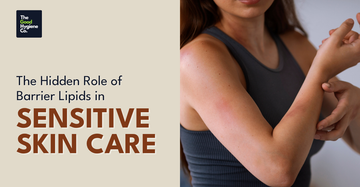When people think of sensitive skin, they often imagine redness, irritation, itching, or that uncomfortable burning sensation after using even the gentlest of products. But beneath these symptoms lies a deeper biological story—one that revolves around the skin’s barrier lipids. These unsung heroes play a critical role in maintaining skin resilience, and their disruption is one of the primary reasons sensitive skin reacts so easily.
In this article, we’ll uncover the science of barrier lipids, explain their role in sensitive skin care, and discuss how products designed to restore them can soothe irritation and rebuild healthy, resilient skin.
Understanding Sensitive Skin: More Than Just a Symptom
Sensitive skin isn’t a medical diagnosis but rather a condition characterized by exaggerated reactions to environmental or topical factors that most people tolerate well. Studies show that up to 60–70% of women and 50–60% of men worldwide report having sensitive skin.
What’s really happening in sensitive skin?
- The skin barrier is compromised, allowing irritants, allergens, and pollutants to penetrate more easily.
- Nerve endings near the skin’s surface become hyper-reactive, amplifying sensations of stinging or burning.(1)
- Barrier lipids—essential fats that keep the skin intact and hydrated—are often reduced or imbalanced, leading to dryness and vulnerability.
This is why sensitive skin isn’t just about what you see; it’s about what’s happening at the microscopic level.
The Science of Barrier Lipids
The skin barrier—often referred to as the stratum corneum—functions like a brick wall:
- Corneocytes (skin cells) are the bricks.
- Barrier lipids act as the mortar, holding everything together.
These lipids mainly consist of:
- Ceramides (around 50% of skin lipids)
- Cholesterol (around 25%)
- Free fatty acids (around 15%)
Together, they form a structured matrix that prevents transepidermal water loss (TEWL) while blocking irritants, allergens, and microbes.
If these lipids are diminished, the wall becomes leaky. Water escapes, skin dries out, and irritants penetrate more easily—triggering inflammation and sensitivity.
Barrier Lipid Deficiency in Sensitive Skin
Research has consistently shown that individuals with sensitive skin have:
- Lower ceramide levels → linked to increased water loss and dryness.
- Imbalanced fatty acids → particularly a deficiency in linoleic acid, an omega-6 fatty acid crucial for maintaining barrier fluidity.
- Reduced lipid organization → leading to micro-cracks in the barrier.
This biochemical weakness explains why sensitive skin often reacts negatively to common irritants like soaps, fragrances, or pollution.
How Barrier Lipid Restoration Soothes Sensitive Skin
When skin care products replenish missing lipids, they do more than hydrate—they rebuild the skin’s defense system.
1. Replenishing ceramides
Ceramide-based creams mimic the skin’s natural lipid structure, filling in the “gaps” of the weakened barrier.
Studies show topical ceramides can reduce TEWL by up to 40% in dry, sensitive skin.(2)
2. Balancing fatty acids
Plant-derived oils rich in linoleic acid (like sunflower seed oil or evening primrose oil) restore fatty acid balance, calming inflammation.
3. Supporting cholesterol levels
Cholesterol works synergistically with ceramides and fatty acids, enhancing lipid layer flexibility and repair.
4. Strengthening microbial defense
A well-lipidized barrier keeps pathogenic bacteria out while supporting beneficial microbes, reducing irritation and flare-ups.
In essence, barrier lipid therapy addresses the root cause of sensitivity instead of just masking symptoms.
Sensitive Skin and External Stressors
Barrier lipid deficiency makes skin more reactive to everyday stressors:
- Pollution: Airborne particles can penetrate weakened barriers, generating free radicals and inflammation.
- Climate change: Low humidity and UV exposure accelerate lipid loss, worsening dryness.
- Harsh cleansers: Sulfates strip lipids, leaving skin vulnerable.
- Psychological stress: Cortisol release has been linked to impaired lipid synthesis, compounding sensitivity.
A product that restores lipids while protecting against external triggers becomes essential for sensitive skin management.
Advanced Formulations: Beyond Simple Moisturization
Not all moisturizers are equal. A true sensitive skin care product designed around barrier lipids should include:
1. Physiological Lipid Ratios
Research shows that a 3:1:1 ratio of ceramides, cholesterol, and fatty acids most effectively repairs barrier function.(3)
2. Lamellar Structures
Some advanced formulations arrange lipids in a “layered” (lamellar) structure that mimics natural skin architecture, enhancing absorption and repair.
3. Anti-inflammatory Botanicals
Ingredients like Chamomile (bisabolol) or Centella asiatica not only soothe irritation but also reduce lipid peroxidation caused by oxidative stress.
4. pH-balanced bases
Maintaining the skin’s natural acidic pH (around 5.0–5.5) ensures optimal lipid enzyme activity.
5. Prebiotic & Postbiotic Support
Supporting the skin microbiome helps prevent further barrier damage and irritation.
The Hidden Link: Barrier Lipids and Skin Sensory Nerves
One lesser-known insight is the connection between barrier lipids and neurogenic inflammation. When barrier lipids are deficient, skin nerves are more exposed and reactive, leading to sensations like stinging or burning.
By restoring lipids, we don’t just fix hydration—we also buffer nerve endings from external stimuli, reducing hypersensitivity at a neurological level. This explains why lipid-rich sensitive skin products often deliver rapid soothing effects.
Daily Strategies for Sensitive Skin Care
Along with using lipid-restoring products, lifestyle and routine matter:
- Gentle cleansing → Avoid harsh surfactants; use lipid-replenishing cleansers.
- Moisturize immediately after washing → Locks in hydration and restores lipids faster.
- Limit hot water exposure → Heat strips away natural lipids.
- Use sun protection → Choose mineral-based sunscreens with added lipids to avoid barrier damage.
- Incorporate omega-rich diet → Foods like flaxseeds, walnuts, and fish oil provide fatty acids for internal lipid synthesis.
The Future of Sensitive Skin Care: Lipidomics
Emerging research in lipidomics (the study of lipid profiles in skin) is paving the way for personalized sensitive skin treatments. Scientists are identifying specific lipid imbalances unique to each person’s skin type, which could lead to customized formulations for optimal barrier repair.
Imagine a future where your moisturizer is tailored to your skin’s exact lipid needs—this is where science is heading.
Final Thoughts
Sensitive skin isn’t just a surface problem—it’s a sign of a disrupted barrier at the molecular level. Barrier lipids are central to this story, acting as the mortar that holds the skin together. When they’re deficient, the skin becomes porous, reactive, and inflamed.
The most effective sensitive skin care products aren’t just “gentle” but are scientifically designed to restore ceramides, cholesterol, and fatty acids in precise ratios. By addressing the root cause—barrier lipid deficiency—such formulations soothe irritation, reduce sensitivity, and build long-term resilience.
So the next time you choose a product for sensitive skin, look beyond the label “for sensitive skin” and ask: does it truly replenish barrier lipids? Because that’s where the hidden science—and the real soothing power—lies.
References:
1. Skin Neurogenic inflammation - 2019 May - https://pmc.ncbi.nlm.nih.gov/articles/PMC6047518/#:~:text=Neurogenic%20inflammation%20is%20mediated%20by,edema%20%5B24%2C23%5D.
2. Skin hydration is significantly increased by a cream formulated to mimic the skin’s own natural moisturizing systems - 2018 Oct - https://pmc.ncbi.nlm.nih.gov/articles/PMC6197824/#:~:text=A%20single%20topical%20application%20of,for%20use%20on%20dry%20skin.
3. Evaluating Clinical Use of a Ceramide-dominant, Physiologic Lipid-based Topical Emulsion for Atopic Dermatitis - 2011 Mar - https://pmc.ncbi.nlm.nih.gov/articles/PMC3070468/






